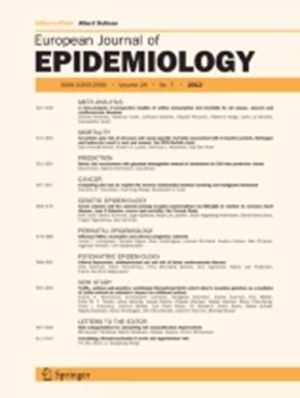COVID-19 infection increases the risk of venous thromboembolism during pregnancy and the postpartum period.
IF 5.9
1区 医学
Q1 PUBLIC, ENVIRONMENTAL & OCCUPATIONAL HEALTH
引用次数: 0
Abstract
Pregnant and puerperal women are at increased risk of venous thromboembolism (VTE) owing to hemostatic changes in preparation for childbirth. The objective of this study was to investigate if COVID-19 infection was associated with VTE in pregnancy or 12 weeks postpartum when considering (prophylactic or therapeutic) anticoagulant use. This population-based register study included all women in Sweden and Norway giving birth after 22 gestational weeks, with conception dates from March 2020 to 2022. A PCR-verified COVID-19 test was used as the exposure, and a VTE diagnosis during pregnancy or 12 weeks postpartum was the outcome. Non-infected women consisted of those testing negative and untested individuals. Cox regression analyses, with COVID-19 infection as a time-varying exposure, and adjusted for maternal characteristics and anticoagulant use, provided overall hazard ratios. To evaluate whether there was a particular increased risk of VTE shortly after testing positive for COVID-19, we estimated time-specific risk of VTE in the first 2, 4, 8, 12, and 16 weeks following COVID-19 infection. Data from each country were first analyzed separately and then meta-analyzed. Among 323,868 participants, 46,048 (14.2%) had COVID-19 during pregnancy, and 80 (0.2%) were diagnosed with VTE. Pregnant women with COVID-19 had a higher VTE incidence rate compared to non-infected (4.9 vs. 2.9 per 1000 person-years; adjusted overall hazard ratio [aHR] 1.26, 95% Confidence Interval [CI] 0.80-2.00). The highest risk was within two weeks of infection (aHR 4.63, 95% CI 2.71-7.90) but remained elevated up to 12 weeks post-infection (aHR 1.86, 95% CI 1.17-2.94). In the postpartum period, 8,515 (2.6%) had COVID-19, and 6 (0.07%) were diagnosed with VTE (aHR 5.17, 95% CI 2.50-10.69). Although VTE post-COVID-19 infection was rare, the infection was associated with increased VTE risk during pregnancy and postpartum, even after adjusting for anticoagulant use. These findings should contribute to the individual risk assessment when evaluating the need for prophylactic anticoagulants in pregnancy and postpartum.COVID-19感染会增加妊娠期和产后发生静脉血栓栓塞的风险。
孕妇和产褥期妇女由于准备分娩时的止血变化,发生静脉血栓栓塞(VTE)的风险增加。本研究的目的是调查在怀孕期间或产后12周考虑(预防性或治疗性)使用抗凝剂时,COVID-19感染是否与静脉血栓栓塞相关。这项以人口为基础的登记研究包括瑞典和挪威所有怀孕22周后分娩的妇女,受孕日期为2020年3月至2022年。使用pcr验证的COVID-19检测作为暴露,结果是怀孕期间或产后12周的静脉血栓栓塞诊断。未感染妇女包括检测呈阴性和未检测的妇女。Cox回归分析将COVID-19感染作为时变暴露,并根据产妇特征和抗凝剂使用进行调整,得出了总体风险比。为了评估在COVID-19检测呈阳性后不久静脉血栓栓塞的风险是否特别增加,我们估计了COVID-19感染后的前2、4、8、12和16周静脉血栓栓塞的时间特异性风险。首先对每个国家的数据进行单独分析,然后进行元分析。在323,868名参与者中,46,048名(14.2%)在怀孕期间患有COVID-19, 80名(0.2%)被诊断为静脉血栓栓塞。与未感染COVID-19的孕妇相比,感染COVID-19的孕妇静脉血栓栓塞发生率更高(4.9 vs 2.9 / 1000人年;调整后的总风险比[aHR] 1.26, 95%可信区间[CI] 0.80-2.00)。感染两周内的风险最高(aHR 4.63, 95% CI 2.71-7.90),但感染后12周仍升高(aHR 1.86, 95% CI 1.17-2.94)。在产后,8515例(2.6%)感染了COVID-19, 6例(0.07%)被诊断为静脉血栓栓塞(aHR 5.17, 95% CI 2.50-10.69)。尽管covid -19后静脉血栓栓塞感染很少见,但感染与妊娠期和产后静脉血栓栓塞风险增加有关,即使在调整抗凝剂使用后也是如此。这些发现有助于在评估妊娠期和产后预防性抗凝血剂需求时进行个体风险评估。
本文章由计算机程序翻译,如有差异,请以英文原文为准。
求助全文
约1分钟内获得全文
求助全文
来源期刊

European Journal of Epidemiology
医学-公共卫生、环境卫生与职业卫生
CiteScore
21.40
自引率
1.50%
发文量
109
审稿时长
6-12 weeks
期刊介绍:
The European Journal of Epidemiology, established in 1985, is a peer-reviewed publication that provides a platform for discussions on epidemiology in its broadest sense. It covers various aspects of epidemiologic research and statistical methods. The journal facilitates communication between researchers, educators, and practitioners in epidemiology, including those in clinical and community medicine. Contributions from diverse fields such as public health, preventive medicine, clinical medicine, health economics, and computational biology and data science, in relation to health and disease, are encouraged. While accepting submissions from all over the world, the journal particularly emphasizes European topics relevant to epidemiology. The published articles consist of empirical research findings, developments in methodology, and opinion pieces.
 求助内容:
求助内容: 应助结果提醒方式:
应助结果提醒方式:


